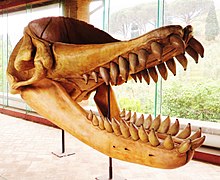Livyatan melvillei
|
Livyatan Temporal range: Tortonian ~9.9–8.9 Ma |
|
|---|---|
 |
|
| Cast of skull at the Natural History Museum of the University of Pisa. | |
| Scientific classification | |
| Kingdom: | Animalia |
| Phylum: | Chordata |
| Class: | Mammalia |
| Order: | Artiodactyla |
| Infraorder: | Cetacea |
| Superfamily: | Physeteroidea |
| Family: | incertae sedis |
| Genus: |
†Livyatan Lambert et al., 2010 |
| Species: | †L. melvillei |
| Binomial name | |
|
Livyatan melvillei (Lambert et al., 2010) |
|
| Synonyms | |
|
|
Livyatan is an extinct genus of sperm whale containing one species: L. melvillei. Its name was inspired by the biblical sea monster Leviathan, and the author of the book Moby-Dick, Herman Melville, where the antagonist is a large sperm whale. It was found in the Pisco Formation of Peru and lived during the Tortonian stage of the Miocene epoch, about 9.9–8.9 million years ago (mya), however a large tooth from Australia implies that either it or a close relative survived into the Pliocene, around 5 mya. It was a member of a group of hyper-predatory macroraptorial sperm whales (or "raptorial sperm whales") and was likely an apex predator preying on whales, seals, and so forth. Characteristic of raptorial sperm whales, Livyatan had functional, enamel-coated teeth on the upper and lower jaws, as well as several adaptations for hunting large prey.
Its total length has been estimated to be about 13.5–17.5 m (44–57 ft), similar to the modern sperm whale (Physeter macrocephalus), making it one of the largest predators to have ever existed. The tallest tooth measured 36.2 cm (14.3 in), and is the largest tooth of any known animal, excluding tusks. It is distinguished from the other raptorial sperm whales by the basin on the skull, and how it spans the entire length of the snout. The spermaceti organ, contained in that basin, is thought to have been used in biosonar and communication, or for ramming prey and other sperm whales. The whale may have interacted with the large extinct shark megalodon (Carcharocles megalodon), competing with it for a similar food source. Its extinction was likely caused by a cooling event at the end of the Miocene which resulted in a drop in food populations. The formation where the whale has been found has also preserved a large assemblage of marine life, such as sharks and marine mammals.
...
Wikipedia
